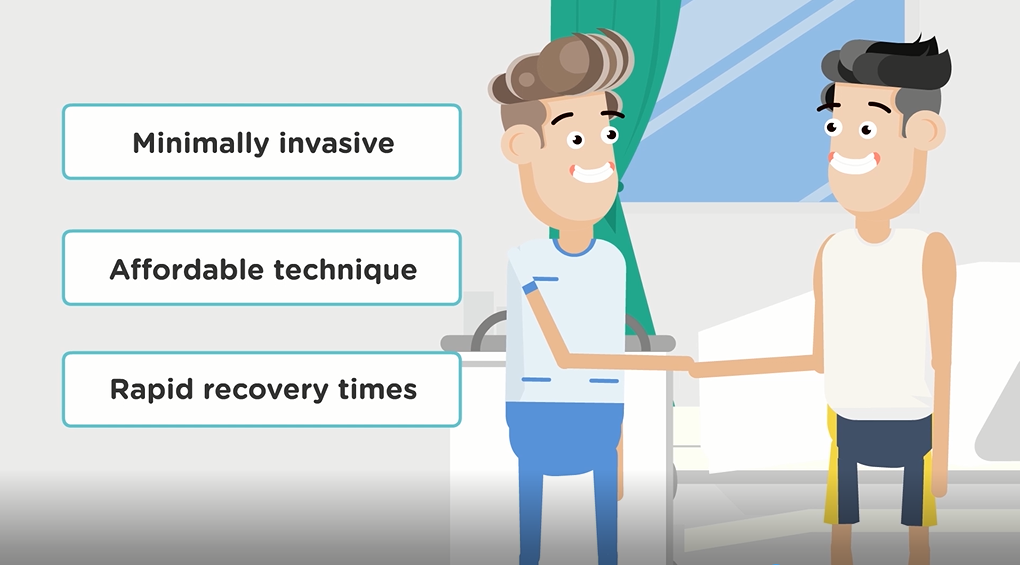The Exostosis Surgery in Detail
Reading time: 8 minutes

Reading time: 8 minutes
Watch a video from our expert about the special technique for treating Surfer’s Ear commonly called the “chisel method“:
Surfer’s Ear is not only limited to surfers, but the condition may occur in anyone who spends
a lot of time in the water.
We believe it is a repetitive rapid change in temperature in ears that are exposed to water and wind that stimulates the bones of the ear canals to start to grow. These narrow the ear canals, ultimately causing water trapping, infections and hearing loss.
No. The local wind conditions and wind chill also play an important role. I have seen many guys with problematic surfer’s ear in one ear only, and the other ear is fine. If the water temperature was the only cause, both ears would be affected equally. With these guys, their home surf or kitesurfing spot has a predominant wind direction, and this is where the wind chill factor kicks in – in surfers this means long hours sitting on the board facing the swell with one ear facing into the wind and getting wind chill. In addition, we are starting to see the condition more frequently in kayakers and fishermen in windy environments like the west coast of Ireland. These guys avoid getting wet if they can. So, yes, you are more likely to get it if the water is cold and you surf in the wind. But being a warm water surfer alone is no protection.
The main reason is that drill surgery is associated with a very high level of noise that can inflict damage to the cochleas of BOTH ears and cause permanent hearing loss. Drill surgery usually requires a cut in the skin either in front of or behind the ear. The surgery generally takes longer with the drill than with the chisel. Drill surgery requires use of expensive consumables like drill bits. Chisel surgery has far less postoperative discomfort and heals quicker as well. I do both ears at the same time, whereas the negatives of drill surgery mean that most people have one ear done at a time, which makes it considerably more expensive.
Well, you must be the one to make that decision. The benefits of getting surfer’s ear surgery must be higher than the risks and negatives, and only you know how much of an issue your ears are to you.
The biggest risk is that you reach a point where avoiding the surgery is no longer an option due to your discomfort, hearing loss and repeated ear infections affecting everyday quality of life. At this point the risks of surgery may now be significantly higher, because the exostoses are bigger and require ‘more’ surgery under a more difficult situation where your eardrum may no longer be visible. In this instance your surgeon will be working ‘blind’ as to the location of your eardrum for the first and most crucial part of the surgery, and the risk of injury to your facial nerve, jaw joint, eardrum and middle ear structures are highest. These are as big concerns to your doctor as to you. While complications are rare, the worse your situation is, the more likely they are to occur.
A ‘difficult’ operation can take more than twice as long as an ‘easy’ operation. With theatre time charged on a per minute basis, this is obviously a factor in people who are not insured in any way for the surgery.
While I can still see your eardrum past the exostoses, the surgery is easier. When the exostoses close the canal completely, the surgery is harder to do. Not impossible by any means, and I still operate on those who want the surgery, but the procedure is more difficult.
In essence, the sweet spot for having the surgery is when you are having symptoms, but before your ear canals are completely closed.
It depends on how much bone needs to be removed, and how close the exostoses are to the drum. A rough estimation would be around one hour per ear. Many cases are significantly shorter than this. Some can take longer.
The relevance of this question is that many hospitals charge per minute for time in theatre unless your doctor has negotiated a fixed rate beforehand. As I generally do. This has obvious implications on the cost of the procedure. Bank on two hours for both ears. This is substantially less than the time required for surgery using the drill.
I prefer to do the ear causing more symptoms first, on the assumption that it will be the trickier ear to do. If all goes well with that side, and with your agreement beforehand, I do the other ear at the same sitting.
Not unless you have a bad reaction to the anaesthetic, with pain or nausea and vomiting. Most patients leave hospital the same day.
The purpose of any check-ups is to remove blood clots and scabs, and to get you back to normal as soon as possible.
The absolute minimum is a check-up three days later to remove blood clots and dressings. The ideal would be another consultation about a week after the surgery.
Those whose schedules do not allow this should ideally have a backup with an ENT in their hometowns. This consultation would be to remove crusts and scabs that are an inevitable part of healing. These will disappear without intervention, but this takes a bit longer.
No. This belief is based on the argument that the blood vessels are enlarged and stimulated by the exostosis and that this somehow causes quicker growth. But that is not true. There is no doubt that failure to protect ones ears after surgery will see them grow back, and this growth may well be quicker than the original, but this is because earplugs have not been worn. The bone in the area is primed to react to temperature changes and will respond faster if the surfer ignores medical advice. The “primed” blood vessels argument is also invalid because we know that people with early exostosis can stop them from growing by using earplugs. If that story was true, the exostosis would keep growing regardless of whether the ears were protected or not.
All surgery carries risk, from the operation itself and from the anaesthetic. The important structures near the ear canal are the ear drum, the jaw joint, the bones of the middle ear and the facial nerve. All these structures can be damaged during the procedure, but in experienced hands the risks are low.
In general, they do, unless they can show that you signed up with them with a pre-existing condition. In which case they may refuse.
The amount they pay out is dependent on your policy. Usually the hospital fees are covered in full, and this is about half the total cost. The surgeon and anaesthetist fees are generally not covered in full, and I highly recommend that you get quotes and negotiate fees beforehand.
For those who can, ‘gap cover’ is an inexpensive insurance to cover those ‘self-payment gaps.’
In addition, our doctor will provide you with a medical certificate, so that you do not have problems with work.
For most people, the worst thing to deal with will be a minor degree of discomfort and blocked ears until the dressings are removed after three days. There are some people who do find the surgery painful, but these are the minority, and medication is available to deal with this. I have no way of predicting who those people might be, unfortunately. Ringing in the ears – tinnitus – is common but will disappear as your ear canals heal.
I suggest you wait until all canal swelling is down, about two weeks. If your ears are protected with plugs to keep seawater out, surfing again should not be a problem. You will be using ear drops regularly anyway for at least a month after the surgery.
My goal with the chisel technique is to get you back into the water ASAP.
Many surfers can avoid repeated ear infections by using earplugs, and there are great products on the market. There are however several scenarios where earplugs are inadequate, and surgery is an option.
Firstly, very few ENT surgeons across the world have the skills to use the chisel technique. There are no ENT surgeons who offer this method in Europe.
Secondly, the chisel method offers a “both sides – one procedure” approach without the use of expensive consumables. For those outside South Africa, our level of expertise, quality of private healthcare, and the considerably lower cost of that healthcare relative to the USA, Europe and UK should make us the destination of choice for the person without money to burn but who wants to be relieved of this condition. Many overseas insurers will cover surgery done in South Africa, so if cost is not the issue, but rather the hope of having easier recovery, we are still very much in play.
Furthermore, our offering is essentially a ‘surgical holiday’ including a one-week kitesurfing course, the surgery itself and a two-week sightseeing program with accommodation, and which all combined is less expensive than the surgery alone in other countries.

It is simply this:
First, we offer the most modern minimally invasive surgery for surfer’s ear with the least discomfort and quickest recovery time at the lowest possible cost. And the cost of the Hospital (surgery theater – no worries, you will be there only for an hour or two) in South Africa’s world quality hospitals is a fraction of that of similar facilities in the USA and Europe. This makes all the difference. With this, we are able to offer a price comprehensive package of care at a saving of up to 75% of that offered in other countries.
We offer you a whole 3-week-program, a full vacation trip, and is still less expensive than the surgery alone would be in other countries (IF they offer the minimal method, which is rare).
The entire offering can be summarized into four points: